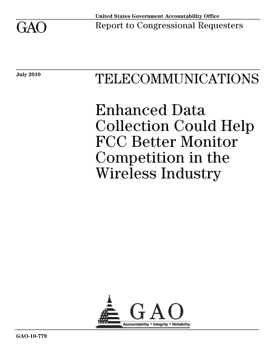New GAO Report on Wireless
Noting that FCC already does an annual Wireless Competition Report and has been changing its structure to keep up with the times, GAO also suggests:
FCC could do more to examine whether or not there is effective competition in the wireless industry. By collecting and analyzing more detailed data on industry inputs and outputs that reflect industry dynamics, FCC could better assess competition conditions throughout the industry. Specifically, FCC could collect more detailed data on such issues as prices, special access rates, and capital expenditures and include analysis of that information in its annual report. These metrics help measure the competitiveness of small and regional carriers, can shed light on the impact of switching costs for consumers, and are, therefore, relevant to monitoring competition in the industry. Despite challenges and costs in gathering these data, such information could help FCC better fulfill statutory reporting requirements. With consumers increasing reliance on wireless services as their primary telephone and Internet connection, more is needed to ensure that FCC and the Congress have sufficient information to make policy decisions concerning the wireless industry.
Long time readers may recall multiple discussions here about the need to radically change cellular carrier’s approach to antenna design to make suburban antennas more compatible with their environments. GAO comments on this general topic:
According to many national wireless carriers, tower companies, and other stakeholders with whom we spoke, the most common barrier to building out a wireless network is local zoning policies and procedures which can delay or otherwise hinder the physical construction and improvement of wireless networks. Wireless carriers must generally obtain state and local zoning approvals before building wireless towers or attaching equipment (co-location) to preexisting structures. Although these zoning processes do not always pose a challenge to wireless carriers and tower companies, in some instances they can encumber buildout by denying zoning permits or by making the process for constructing cellular towers and antennas cost prohibitive. Many stakeholders with whom we spoke said that in California, for example, there continues to be significant public concern over the aesthetic and health impacts of wireless infrastructure. As a result, locating wireless facilities can be challenging in cities such as San Diego and San Francisco. Other stakeholders told us that, as wireless networks have expanded into residential areas, residents have raised concerns about aesthetics and safety, making it difficult to provide the capacity necessary to serve the growing demand for wireless services. Washington, D.C., and other cities with unique or historic buildings and skylines can also impose limitations on network build out, such as height restrictions on towers.
Local governments and wireless entities have generally been able to reach agreements on the conditions of wireless network construction, despite the challenges noted above. Some local jurisdictions have developed ordinances specifically for wireless infrastructure in order to make their preferences and requirements clear to carriers and tower companies. Carriers have also developed and adopted a variety of disguising or “stealthing” technologies that help mask towers and other infrastructure. Figure 14 shows a stealth tower in Eureka, California, where the antennas were hidden inside a bell tower on church grounds. In San Francisco, to avoid aesthetic concerns and procedural challenges, wireless carriers have developed Distributed Antenna Systems in recent years. Instead of using large towers or antennas on buildings, these systems involve a series of small antennas, deployed low to the ground, often on utility poles, that together provide wireless coverage.




![Validate my RSS feed [Valid RSS]](valid-rss-rogers.png)

